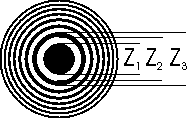Zone Plate Math

Each "ring" in a zoneplate, whether black OR white is called a zone index. See above negative image of a zoneplate.
The formula for finding the width of each zone index (Zi) is:
Zi = 1.86 X squareroot(focal length X index# X wavelength)
So, for a focal length of 50mm and daylight (0.00056 mm), the first index [center circle] is:
1.86 X squareroot(50 X 1 X 0.00056)
which equals 0.311mm
This first index is important, as it's value is the same as the ideal pinhole for the same wavelength.
p = squareroot(focal length/constant)
in this case p = squareroot(50/514) which equals 0.312 [close enough] see PINHOLE MATH
You then carry out the calculations for as far as you wish. The above example is a 15 index zoneplate [15 zones of alternating black and white]. You will find as the rings get thinner and thinner, that the possibility of resolving them when making the zoneplate diminishes. So, there is a practical limit of how far out you can go.
The 1.86 value in the above formula is a constant that I worked out as being the best one for zoneplates. Others have determined different values (values calculated from their pinhole constants):
| Rayleigh (1891) | 2.00 |
| Patton (2000) | 1.86 |
| Turner (1941) | 1.64 |
| Pinhole Resource (?) | 1.54 |
| Blaker (from Kingslake 1963) | 1.28 |
PRACTICAL CONSIDERATIONS
It is not practical to make an image with a 0.311mm center. The trick is make it 25 times larger and then reduce it in photography. Simply multipy each of the zoneindex values you get above by 25 and draw out the zoneplate.
PHOTOGRAPHING THE ZONEPLATE
Whatever film format you use, use a high contrast, high resolution film such as Technical Pan. If you use a negative film [like tech pan], make sure the center circle of your zoneplate image printout is black, so when it is photographed onto film it becomes clear.
The BEST results will be with a lith film developed in a lith developer. Admittedly all of the above is getting more difficult as more and more companies are getting out of the film business. Kodak no longer sells either Technical Pan or Kodalith in 35mm. Try Freestyle Photographic Supplies for an alternative.
Distance = Magnification X (F + F/Magnification)
where Magnification is greater than one
F is the focal length of the lens used to do the copy work (for instance a 50mm lens on your 35 mm camera)
So, in the case where we made a 25X zoneplate and are using a 50mm lens to copy it:
Distance = 25 x (50 + 50/25) = 1300mm = 51 inches = 4 feet 3 inches
Once you have determined this distance, you can photograph the same zoneplate print from different distances to achieve different focal length zoneplates. You need not print a different pattern for each focal length.
New Distance = Current Distance X squareroot ( Current focal length / Wanted focal length)
As a check on your calculations, you should move closer for a longer than current focal length lens and father away for smaller than current focal length lens.
If we use the above example to go from a 50mm zoneplate to a 100mm one:
New Distance = 1300 x sqrt(50/100) = 1300 x sqrt(0.5) = 1300 x 0.707 = 919 mm or 36 inches
(If you do not want to draw your own pattern, here is an Adobe Acrobate [pdf] file of a 100X image of a 75mm zoneplate [negative] with 29 zones.)
FOCUS
Another consideration is that the farther out you go, the more light gets in and the lower the effective f#. This limits your depth of focus. Unlike "regular" pinholes, zoneplates are more like hyperfocal lenses. They do have a point of "sharpest" focus.
The "effective" f# is the outer zone. In the case of a 50mm zoneplate with 15 zones this is 1.205 mm or f41.5. Consider that the ideal pinhole for the same focal length is 0.311 or f161, this is a huge difference. The actual amount of light that gets in is less, remember those alternating opaque rings, but the "optical" f# for purposes of depth of focus, etc. is the f41.5.
It is not always practical to focus a zoneplate camera. You can do one of two things. Either calculate the focus for a given subject distance or use the hyperfocal distance.
given distance method:
1/F = 1/S + 1/D, there F = the focal length, S = the subject distance and D = the distance to the film plane.
Example. Say I want to photograph my friend who is one meter away [I am sticking to metric, but the formula works for standard also, as long as ALL the measurements are in the same system, you can't mix metric and standard.].
So,
1/50 = 1/1000 + 1/D
0.02 = 0.001 + 1/D
0.019 = 1/D
D = 1/0.019 = 52.63 mm
This means that instead of the zoneplate being 50mm away from the film plane, it is 52.63 mm away for the best focus.
hyperfocal method:
figure out the focal length and the f# for your zoneplate. decide what film format you will be using [35mm? 4x5?], then use the same equations as for the hyperfocal cameras. see HYPERFOCAL MATH
Pinsieve [pinhole sieve or photon sieve]: The only difference is that the pinholes that make up the rings are made by centering 1.5x diameter pinholes on the rings and then deleting the rings. See See Guillermo Penate's site. Based on work from the Nature 414, 184-188 (8 November 2001) paper.

Pinsieve [or Pinplate] the overlapping image Zoneplate
PDF [481KB] of 50mm and 75mm 25X images of both Pinsieves and Zoneplates.